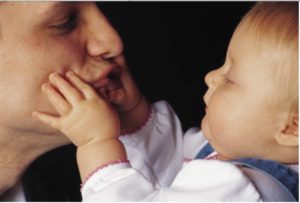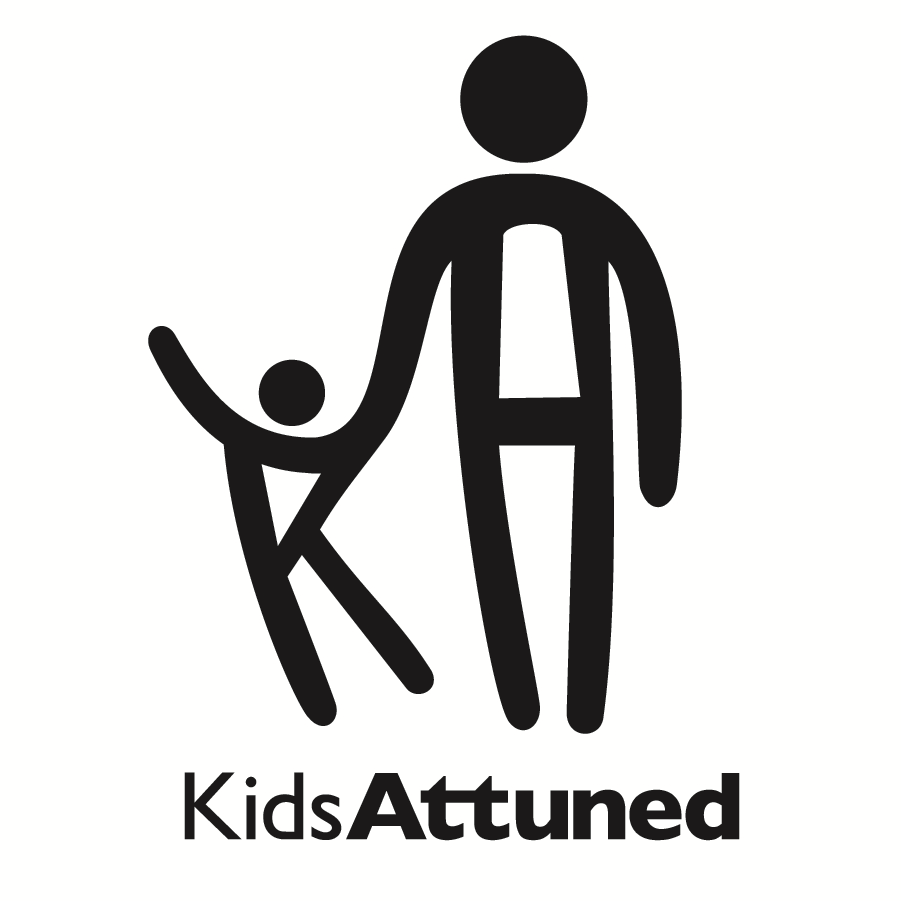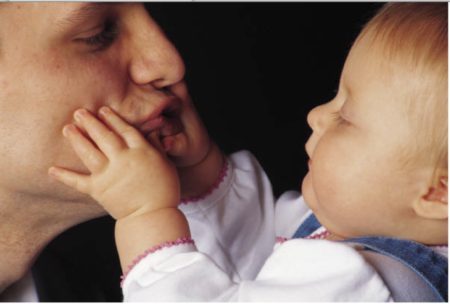ANGELS IN THE NURSERY AS THERAPEUTIC AGENTS

In our treatment of stressed and traumatized infants, toddlers, and preschoolers and their parents, we are confirming and extending to younger ages findings about the importance of two key ingredients in the treatment of trauma: (a) supporting developmental progress and (b) encouraging the (re-)discovery and practice of pleasurable emotional investment in the self, others, and the world through the affective experience of interest, enthusiasm, joy, elation, self- confidence, reciprocity, intimacy, and love (Lieberman, Compton, Van Horn, & Ghosh Ippen, 2003; Marmar, Foy, Kagan, & Pynoos, 1993; Pynoos & Steinberg, 2004; van der Kolk, 2003). Traumatized children and adults engage in defensive maneuvers such as overreacting to internal or external stimulation or withdrawing from engagement with activities of daily living. There is substantial empirical evidence that resilience, as defined by the ability to withstand and cope effectively with adversity, is fostered by secure attachments, positive emotional bonds to sup- portive and competent adults, confidence in oneself, and motivation to act effectively on the environment (Heller, Larrieu, D’Imperio, & Boris, 1999; Luthar, Cicchetti, & Becker, 2000; Masten, 2001; Osofsky & Thompson, 2000). The therapeutic setting should provide a protective sphere not only to explore painful events but also to retrieve and integrate experiences that promote self-worth.
What accounts for the repression of angel-like early experiences? Memories of early well-being may bring about a sense of despair over its loss from the perspective of later adverse circumstances. The unfulfilled wish for a happier life course can trigger grief and mourning for missed opportunities. The reexperience of lost goodness can make the loss even more painful, making the retrieval of angel-like memories a destabilizing emotional experience. On the other hand, when the baby or small child becomes the evoker of good memories, the parent’s ability to do well by the baby can become an incentive and a reward. The parent may think that “I can be good to my baby even when I cannot be good to myself.” This can become the starting point for being good to the baby as a way of being good to oneself. The therapist’s support in making this transition is an essential ingredient in this process. The following clinical vignette is an edited verbatim transcription from narrative session notes.
Therapeutic Vignette
“I conduct weekly Spanish-speaking support group for monolingual Spanish-speaking Latina mothers residing at the shelter. At the end of every group session we have a ritual where each of us briefly says a phrase or a word that holds special meaning and elicits inner strength. In this session, three of the mothers had a very difficult time coming up with a phrase or word. When they did, they used words they had heard from others as a way of encouraging them, such as esperanza (hope) and fortaleza (endurance). These mothers did not show significant emotional reactions or changes in their facial expressions and body language when explaining why they chose these particular expressions. Indeed, their affect was flat and constricted. The fourth mother, Mrs. Romero, responded very differently. The word that came to her mind was ‘guagua,’ a Quechua word that means ‘baby.’ She said that this word literally ‘fills her up’ with wonderful memories about being loved and cared for by her mother. While she was describing the personal meaning this word had for her, her affect immediately shifted from sorrow and sadness to joy and pleasure. Her body language and facial expressions reflected peacefulness and joy. The room was literally lit up with the big smile she had on her face. She explained that whenever she gets distressed or depressed, or whenever her one-and-a-half-year old son gets angry or frustrated or does something that makes her upset, she is able to use the word ‘guagua’ to regain her inner balance and re- establish a more harmonious interaction with her son. By saying ‘guagua,’ she vividly remembers the patience her mother had, and how her mother was able to calm her down and comfort her when she was sad, upset, scared, or angry. She concluded by saying that the word ‘guagua’ reminds her that she is a good person and mother who can care for herself and her child. It clearly speaks to her sense of self-efficacy as a mother.”
This mother consciously relied on her benevolent early experiences to guide her behavior toward her son. When these memories are not spontaneously available, the therapist’s emotional availability can serve as a reminder that enriches the parent’s ability to take care of the child, as in the following example.
Therapeutic Vignette
Mrs. Arenas participated with her 4-year-old daughter in child – parent psychotherapy following separation from her husband due to domestic violence. Mrs. Arenas had been abandoned by her alcoholic parents at an early age, spent her childhood in several foster homes, and was adopted at age 8 by a family who could only provide intermittently adequate care. Nevertheless, she felt intense, if ambivalent, love for her adoptive parents, and struggled courageously to be a good mother to her daughter.
During the session described next, the therapist arrived for a home visit to find both mother and child in an angry mood. The child, Nancy, greeted the clinician by sticking out her tongue and promptly hiding behind an armchair and refusing to engage with her. The mother busied herself around the kitchen, barely acknowledging the therapist’s presence. When the therapist inquired about what was happening, the mother said: “I am just bored.” The therapist replied playfully, “Well, I can keep you company and we can be bored together, or if you prefer we can do something that youall like.” Nancy said in a whiny tone that her mother had put her on time out for messing up the string of a kite they were trying to fly in the back yard. The mother confirmed this, saying in an irritated tone: “The last thing I want to do is sit with that damn string and untangle it.” The therapist approached the mother and said, out of the child’s
hearing: “If you want, I can try to untangle it. You’ve been taking care of Nancy all day, and I can see that youneed a break.” With the mother’s relieved permission, the therapist untangled the string to shrieks of delight from the child and a pleased expression from the mother. When they all went to the backyard to fly the kite, the mother’s mood became unexpectedly bright and warm. She encouraged her daughter to fly the kite, saying “Run, Nancy, run!” and giving her useful pointers about how to keep the kite in the air as she ran alongside helping unobtru- sively. After about 20 min of this play, she sat out of breath next to the therapist on the back steps to the house, saying wistfully: “My father taught me to fly a kite. We would do it every weekend during the summer. It was so much fun.” Once back inside the house, the mother brought out the family album and showed the photos to the therapist and to Nancy, patiently explaining the identity of each person. The child pointed to the photo of her parents’ wedding day, saying “Her got married!” The mother corrected her grammar gently, and went on to comment that this was the first time she had looked at the photos in a long time.
How can we understand this sequence of events? The therapist had the distinct impression that the angry and distant mood at the beginning of the session had been triggered by the child’s unwitting entangling of the kite’s string, which for the mother was associated with one of the few pleasurable memories she had of her adoptive father. The therapist had restored the in- tactness of the memory by untangling the string and by making possible a joyful reliving of kite flying, this time with the mother guiding her child as her father had once guided her. This spirited physical reenactment had, in turn, allowed the mother to integrate her adoptive family into her present family, sharing with her daughter and with the therapist the people who were important in her childhood and the pivotal picture of her wedding, an event that was at the center of her conflict over her infidelity and her struggles to form the kind of family she had never had.
The capacity to integrate the good and bad parts of a love object into a sturdy sense of object constancy has long been considered the hallmark of the adult capacity to love (Fairbairn,
1954; S. Freud, 1923/1966; Kernberg, 1976; Klein, 1932; Mahler et al., 1975; Winnicott, 1965). Such integration is particularly difficult to achieve when the same parent is simultaneously attacker and protector, the source of fear as well as the provider of safety and well-being. It is possible that having a realistic sense of the danger posed by the abusive parent while holding on to the loving and protective aspects might be an indicator of a traumatized person’s capacity to recover from trauma. In this sense, we might think of the ability to retain loving memories as one of the building blocks of psychological health. The poet Tom Clark (1971) wrote: “Angels carry messages — like DNA?” (p. 41). We can extend this image by proposing that the messages carried by ghosts and angels may form a “double helix” where opposites come together in a life-supporting integration.
The metaphor of ghosts and angels is not restricted to the inner experience of adults. Children can give us perhaps the most illuminating glimpse into the ability to contain opposites. In the following transcript of a therapeutic session with Rowena, a young girl, we see her struggling with her simultaneous love for and fear of her father as she arrives at a solution through the medium of play.
Therapeutic Vignette
Rowena, age 5 years, had been living with her paternal aunt pending reunification with her father, from whom she was removed because of severe neglect and rages related to his alco- holism. The father, Mr. Smith, had been sober for the past 3 months and Child Protective Services initiated overnight visits as the first step toward reunification. Rowena often expressed joy at the prospect of spending time with her father and said thatshe wanted to live with him; however, in the therapeutic session described here, her play suggested more mixed feelings. The treatment took place in the home, with the therapist bring- ing a bag of toys that were used during each session. Rowena started the session by pretending to call her aunt on the toy telephone and said: I get very scared when I sleep with my daddy. I have nightmares when I sleep with my daddy. I want to sleep in the living room, but my daddy won’t let me. He makes me sleep in the same room with him.
When the therapist asked what made her scared about sleeping with her father, Rowena re- mained silent and did not respond. Instead, she prepared a small bed in a corner of the room and put a doll to sleep on it, saying “the baby is sleeping here.” She then pulled out about 20 plastic animals, one at a time, and she lined them up in front of the bed, near the baby’s head. She explained that the lions and tigers were trying to attack the baby, but the other animals made a row to protect her. She was very engaged in the play, carefully moving the different animals to make sure they were aligned very close to each other in a solid protective layer. She then said, “The animals are like the fairy godmother, taking care of the babies.” She then climbed on her bed (The session took place in the child’s bedroom.) and asked the therapist and the aunt to line up all the animals to protect her. They did so, commenting that she was protected and safe.
This child’s fear of sleeping with her father gave rise to concerns about possible sexual abuse, but there was no evidence that this was the case. We hypothesized that the child was demonstrating a developmentally appropriate effort to establish the proper role boundaries between herself and her father, and that the desire to sleep separately might be further intensified by the lingering fears of her father’s drunken rages during the night while he was still drinking. We also hypothesized that the animals represented the concerted efforts of her aunt and other relatives to keep her safe. In the absence of a reliable mother figure, this child needed to array a veritable battalion of protective forces to feel secure, but it was to her advantage that she had the creativity and inner resources to do so.
The process of psychotherapy may evoke suppressed memories not only of painful ex- periences but also of supportive ones. These newly emerging memories can be conducive to a radical reorganization of the self in relation to attachment figures. In child – parent psycho- therapy, parents may be unexpectedly reminded of aspects of their childhood that had long remained outside awareness by the child’s developmental stage, changing physical appearance, or evolving developmental milestones. The parent’s sense of self may then become enriched by the integration of a more generous and compassionate view of the attachment figure.
Therapeutic Vignette
Mr. Robertson and his son, 4-year-old Martin, came to treatment because Mrs. Robertson believed that the father – son relationship was becoming damaging to family harmony as the result of Mr. Robertson’s excessive teasing, ridiculing, and disciplining of the child. Mrs. Robertson reported that Martin had become increasingly clingy, fearful, and dependent on her as the result of his father’s behavior. This situation had worsened considerably after the birth of the couple’s second child, who was now 6 months old. Mrs. Robertson had hoped that the relationship between Martin and his father would improve after the birth of the baby because they might join forces while she busied herself with the child, but the opposite had occurred. She reported that she had decided that the father and son needed what she termed “couples’
therapy” on an afternoon when the father returned home from work unexpectedly early. Martin, who had been in an excellent mood until the father’s arrival, became subdued and insisted on staying in his room reading a book.
During the initial assessment, Mr. Robertson’s description of his relationship with his father resembled in precise ways what Mrs. Robertson had described in his treatment of Martin. Mr. Robertson, Sr., now deceased, had been an extremely accomplished businessman who had exacting standards for his son. Mr. Robertson, Jr. could match most of these standards because he was very intelligent and loved school, but he could not match his father’s expectations in the area of sports. He was not well coordinated and his peers teased him and shunned him when a teammate had to be chosen. His father compounded this experience of humiliation by yelling at him to “try harder” and calling him a “mamma’s boy” and a “weakling” in public when he failed at a sport. Physical punishments were frequent and frightening, although they did not seem to involve reportable incidents. The child – parent psychotherapy sessions focused on helping Mr. Robertson give Martin the space to play freely, without admonishing him about doing things wrong and without directing the play to make it more coherent or adultlike.
On one particular session, Martin was able to tell his father what he needed from him. As he was trying unsuccessfully to complete a puzzle, his father asked: “Why don’t you ask me for help?” Martin replied: “I ask for help when I can get help.” This candid answer hurt the father deeply, but it made him understand, for the first time, that Martin did not perceive him as helpful when he offered suggestions to improve the child’s performance. This session was followed a few weeks later by an individual session with the father where he spoke bitterly about his own father’s simultaneous unavailability and authoritarianism. He seemed to find nothing to like about his father; inquiries from the therapist about moments when he could rely on his father were met with angry denial. During the following child – parent session, however, Martin turned to him and said: “Now you can help me, daddy.” Mr. Robertson, who had been watching him with a blank expression, smiled brightly and said: “What can I do for you?” Martin replied: “You can put the baby to sleep.” Mr. Robertson took the baby doll and put it on the crib, humming softly. Martin huddled against him, and the father put his arms around his son.
Mr. Robertson later reported that this exchange suddenly brought to mind scenes from his childhood when he and his father would lie in bed together on Sunday mornings watching Martin’s favorite children’s program. He said “I used to be still sleepy, and my father would cuddle with me and I remember how strong he felt and how he smelled — I remember wanting to smell like him when I grew up.” This memory was in sharp contrast with his previous denial that his father had done anything loving for him while growing up, and it became the first of other positive memories that counteracted his one-sided negative perception of his father and enriched his own relationship with his son. This sequence illustrates that the therapeutic process may help in the recovery of positive memories from the past that were covered over due to the normal process of forgetting or as the result of unconscious motivations.
* * *
Enter the text or HTML code here

